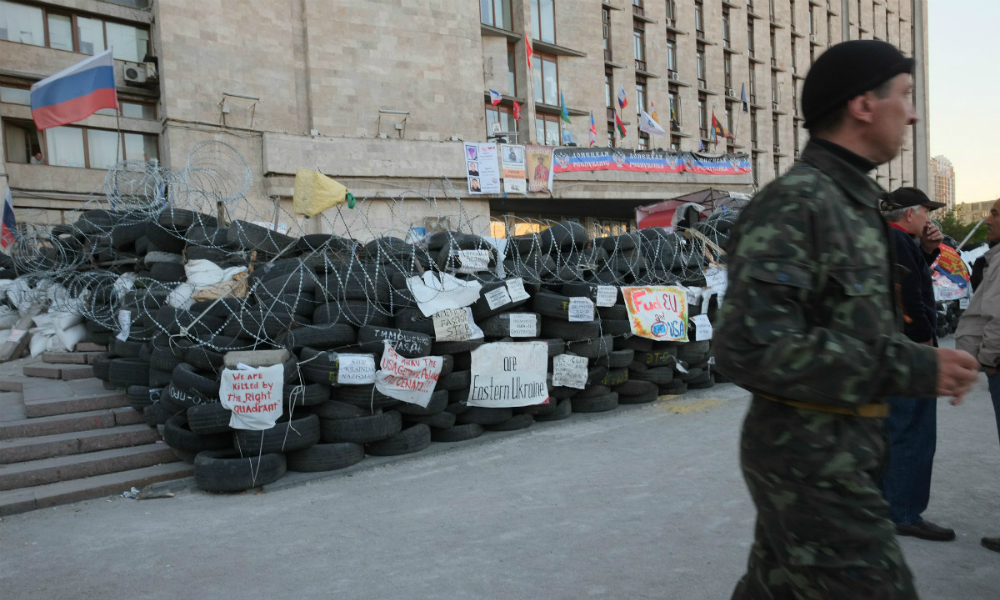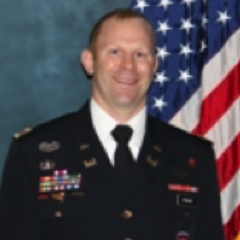Editor’s note: This piece is based on the author’s MWI report, “Countering Hybrid Threats in the Gray Zone.” Read the full report here.
Since Russia’s intervention in Ukraine began in early 2014 and “little green men” began to appear throughout the troubled country’s eastern regions, both hybrid threats and the so-called “gray zone” between peace and war have received a great deal of attention. While hybrid threats have a long record of use throughout military history, recent events—chief among them Russia’s current adventure in Ukraine and the emergence of its “New Generation Warfare” doctrine—have rightly encouraged strategists, scholars, and policymakers to examine U.S. vulnerability to hybrid threats and conceptualize methods to counter them in the gray zone.
The U.S. military is uniquely vulnerable to hybrid threats and gray zone actions for a number of reasons. Chief among these are that (1) the overwhelming military advantage the United States has over its potential adversaries discourages them from choosing to confront the United States and its allies in traditional forms of warfare and instead forces them to rely on hybrid tactics and gray-zone actions to attack where we are weak; (2) US doctrine splits military operations into discrete forms and operational planning into finite phases, leaving seams that are exploited by hybrid tactics; and (3) adversaries use gray-zone hybrid threats to take action in areas where the Department of Defense is often not the lead agency and, as a result, adversaries are able to quickly get inside the decision cycle of the interagency process to prevent the United States from adequately responding and countering the threat. So what can the United States, and in particular the US Army, do to minimize vulnerability and counter hybrid threats, a tool for comparatively outmatched forces aligned against more powerful adversaries? The following are concrete steps the Army can take in order to effectively prepare for and succeed against hybrid threats in the gray zone.
1. Strengthen Unconventional Warfare Capabilities
Because of their unique capabilities, special operations forces are the quintessential force for actions in the gray zone and the US Army must continue to build upon their unconventional warfare (UW) capabilities in order to successfully counter aggressive actors in the gray zone. UW is defined as “activities conducted to enable a resistance movement or insurgency to coerce, disrupt, or overthrow a government or occupying power by operating through or with an underground, auxiliary, and guerilla force in a denied area.” Countering hybrid threats in the gray zone requires many of the tactics, techniques, procedures, and capabilities intrinsic to UW.
Recent uses of UW by the US Army special forces include the beginning of the war in Afghanistan, when US special forces enabled the Northern Alliance to overthrow the Taliban, and working with the Kurds in northern Iraq in 2003. However, the majority of US Army special forces operations over the past fifteen years were focused on counter-terrorism, stability operations, or foreign internal defense. It wasn’t until the recent operations against ISIS in Syria that US special forces regularly conducted UW. Consequently, their ability to conduct UW has atrophied and the institutional knowledge about UW, that resided among enlisted special forces members, has largely disappeared. The Army has reorganized its special forces specifically to emphasize preparedness to confront hybrid tactics, but it is critical that mechanisms are put in place to ensure rebuilt UW capabilities are protected from the erosion seen over the past decade and a half.
Additionally, the Army must prevent further cuts to its special operations forces and, if possible, increase its civil affairs and military information support operations capabilities. These forces are crucial for going into environments, building networks, identifying organizations that would be helpful in resisting an aggressor, and conducting operations to influence at-risk populations. Consequently, they possess skill sets that are essential to countering hybrid threats in the gray zone.
2. Boost Civilian Education Opportunities for Special Forces
The Army should continue to increase broadening opportunities focused on advanced civil schooling for officers and senior non-commissioned officers serving in special operations forces. In complex, gray-zone environments, it is important that we have highly competent, educated personnel who can think critically and put individual actions of an adversary into the context of a broader strategy. Given the current force structure and where the US Army’s unconventional warfare capacity resides, it is likely that the soldiers operating in the gray zone will be NCOs and officers serving in military intelligence, special forces, civil affairs, and military information support operations specialties.
An important means of acquiring depth in specific subject areas and improving necessary critical and creative thinking skills is the advanced civil schooling program (ACS). ACS provides the opportunity for officers to become fully immersed in an academic environment and focus on specific areas of expertise. However, the ACS program is currently only open to officers and offers the opportunity to only 412 students each year. This program should be expanded to offer more opportunities to junior officers prior to taking detachment command in the special operations community and to special operations forces NCOs—those likely to be on the ground in the gray zone, making the majority of assessments and executing US policy.
The financial cost of offering these opportunities is not extraordinary. Sending 1,000 officers and NCOs to a two-year program costing $30,000 per year would cost the Army $30 million per year (plus any potential adjustment in housing allowances). This is less than the price of one Apache helicopter ($35 million) and a little more than one Paladin/FAASV Integrated Management system ($25 million). As ARSOF 2022 states, “humans are more important than hardware” and, thus, 1,000 critical thinkers are of much greater value to the Army than a single Apache or Paladin and the investment is well worth the cost.
3. Pre-position Forces in Countries at Risk of Hybrid Tactics from Adversaries
When responding to gray-zone hybrid threats, one danger faced by US decision-makers is the risk of escalation associated with moving forces into the region. To circumvent this, it is prudent for the US Army to position forces in countries susceptible to gray-zone incursions by adversaries. The presence of even a small US force in an at-risk country amplifies the risk for a potential aggressor that gray zone actions might result in an engagement of the US forces.
Operation Atlantic Resolve is an example of what this pre-positioning might look like. Atlantic Resolve is a multitude of multinational training and security cooperation activities taking place throughout Eastern Europe in support of the United States’ NATO allies. US forces’ presence accentuates the risk involved for any Russian contemplation of gray zone actions inside the borders of its Baltic neighbors, for example, thereby serving as a vital deterrent.
Pre-positioning US forces does have costs, both financial and in terms of restricting US options in the event that a potential adversary chooses to challenge US resolve by undertaking operations despite the American force presence. These costs must be weighed against the very real deterrent effect of positioning forces in at-risk countries.
4. Support Efforts to Integrate At-Risk Minority Populations in Vulnerable Countries
The United States should also work with host nations to integrate minority ethnic groups and other at-risk populations. In the case of Eastern Europe, ethnic Russians have provided a key component of Russia’s hybrid warfare strategy. In Ukraine, the Russian minority makes up 17 percent of the population, and protection of this group became a key pillar on which Russia justified its involvement in eastern Ukraine. In the Baltics, other countries whose pro-Western governments could make them vulnerable to Russian operations have even larger Russian minority populations: 25 percent in Estonia and 26 percent in Latvia.
Working to integrate at-risk ethnic groups and remove a vulnerability that aggressors could exploit will necessarily be led by host nation governments and other US government agencies. But the Army can play a valuable contributing role, particularly in nations in which the military has a uniquely effective relationship with the host nation government. Civil affairs units would be especially well equipped to support outreach and integration programs.
5. Work with Host Nations to Build Non-Violent Civil Resistance Capabilities
Finally, the United States government should work to build non-violent civil resistance capabilities in at-risk countries. In the gray zone, it is possible that an aggressor may move to seize territory before the United States can respond or has the political will to respond. In order to help undermine the ability of the aggressor to seize and hold this terrain, it is necessary to build capabilities in countries that may not have the military force to resist the aggressor nation (for example, small countries in Eastern Europe). One way to do this is to build the capacity to conduct non-violent civil resistance—protests, sit-ins, traffic jams, work stoppages or slows, and other types of disturbances that disrupt the activities of an occupier.
Here again, the Army will play a valuable role, but one in support of other US government agencies. Special forces Operational Detachment-Alpha’s (ODAs) and civil affairs teams are in a unique position to help build capacity for non-violent civil resistance. Special forces’ capabilities in unconventional warfare—the main goal of which is to enable a resistance movement to disrupt a government or occupying power—make ODAs uniquely equipped and trained to facilitate non-violent civil resistance. In order to build capacity within host countries, special forces ODAs and civil affairs teams should work with host nations to develop plans for non-violent civil resistance, identify and build relationships with community leaders and organizations that could be mobilized to implement a non-violent civil resistance plan, and train host-nation military forces in conducting unconventional warfare. This can be done either overtly or covertly depending on the specific country situation and political landscape.
Steps have been taken to implement non-violent civil resistance techniques in some NATO countries in Eastern Europe. In particular, Latvia introduced a manual in 2015 that highlights what institutions can do and what actions civilians can take to non-violently challenge an aggressor who occupies their territory. The US Army should build on this manual and help distribute it or recreate it in states at risk of being occupied by an aggressor.
Building capacity for non-violent civil resistance may not be as sexy as other responses to hybrid threats in the gray zone. However, it is a relatively low-cost initiative that can be achieved with minimal troop commitment and has the potential to be more successful than armed conflict. Furthermore, it is a strategy that buys the United States and international institutions time to formulate a response and build the political will necessary to undertake wider operations to counter an aggressor’s hybrid tactics.
Finally, each of these steps must necessarily be nested within a whole-of-government approach to preparing for and responding to hybrid threats. For some—integration of at-risk populations and building non-violent civil resistance capabilities—the Army will necessarily play a supporting role to the Department of State and other agencies. But across the board, because a chief advantage inherent to gray-zone hybrid threats is their ability to exploit slow-moving and heavily bureaucratic planning procedures, it is vital that the Army embraces the interagency process to ensure that obstacles to implementation of any plan to counter gray-zone hybrid threats are minimized.
Image credit: dasjo



Excellent Article
Captain Chambers, your excellent article reflects the kind of lateral and interdisciplinary thinking and action that are necessary to succeed in an increasingly ambiguous and non-linear world. If your article reflects the values and intent of how we educate our future military leaders then our nation is in very good hands. Keep up the good work.